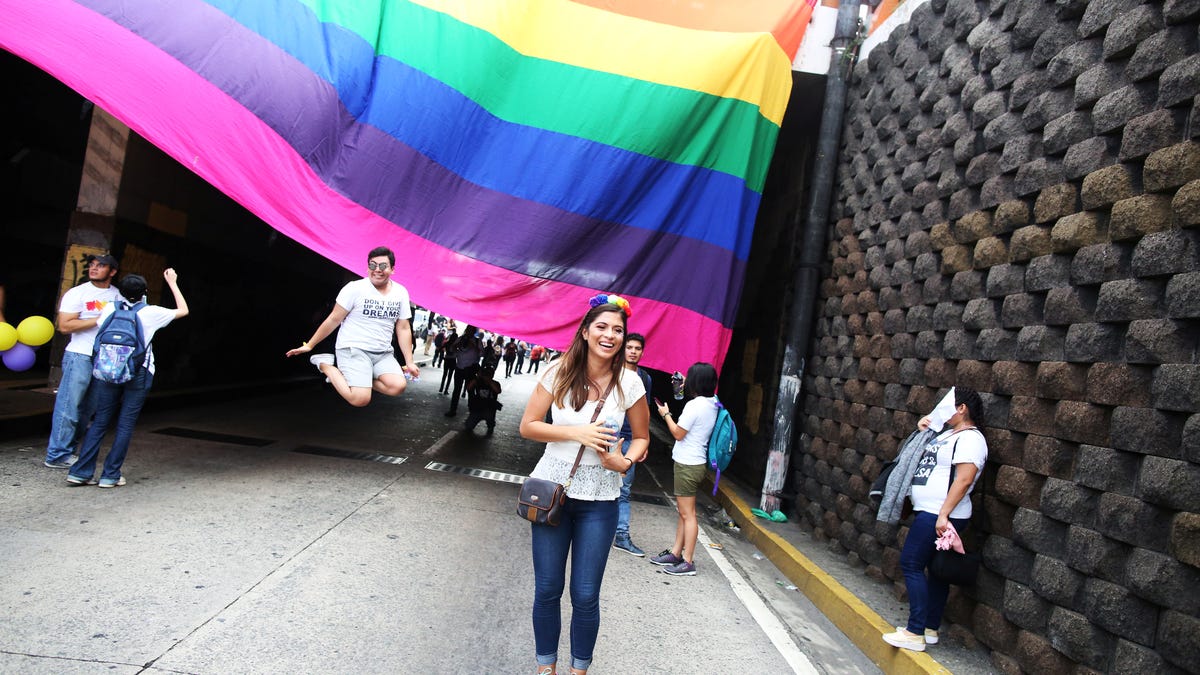
Last year, the US Centers for Disease Control released its national survey of high school students, called the Youth Risk Behavior Survey, as they’ve done every other year for decades. But this time, there were two new questions.
One asked students about their sexual orientation; the second asked the gender of their partners. States could choose which CDC questions to ask their teens; 27 states agreed, enough, researchers believe, to offer data that can be extrapolated to the rest of the country. That made it the first-ever national survey to parse high schoolers by sexuality.
For the first time, we know that some 1.3 million kids, or roughly 8% of all high school students in America, report being lesbian, gay, or bisexual.
Digging into the data, though, as Laura Kann, the lead author on the survey put it, is “truly heartbreaking.” Kann has been working with CDC data from high schoolers for 30 years.
Nearly 18% of lesbian, gay, and bisexual students reported having been raped at some point in their lives—more than three times the rate of straight students. They were twice as likely to be bullied, both online and on school property, and more than twice as likely to stay home from school to avoid violence they felt might befall them on the way there, or on school grounds. Almost 30% had attempted suicide, more than four times the rate for straight students, and 60% reported feeling “sad or hopeless,” twice the rate of their straight peers. They also used hard drugs far more often: 6% reported using heroin at least once, and 5% reported injecting a drug intravenously, which was four and five times the rate among straight kids, respectively.
The numbers made very clear what activists have been saying for decades: The public health of queer youth must be documented, recognized, and protected.
The struggle to get LGBT health taken seriously as a distinct category of risk goes back several generations. For decades, while homosexuality was on the books as a mental disorder, the US turned a blind eye to the actual mental and physical health needs of LGBT people, while continuing to pathologize them—homophobia was basically enshrined in the medical literature.
In the 1970s, “gay people were considered to be mentally ill, so no one was thinking about physical health,” says Caitlyn Ryan, a clinical social worker who has been working on LGBT health issues for nearly 40 years in California. “There were very few young people who were out. Gay bashing was routine. The level of antipathy, of anger, of prejudice, was higher. There just wasn’t access. Health providers would provide painful care—they would inflict pain on a gay patient, if they knew they were gay. People were dying alone, because their partners would not be allowed to be with them.”
The American Psychiatric Association voted to remove homosexuality from the Diagnostic and Statistical Manual of Mental Disorders in 1973, but the effects of years of pathologizing being gay rippled on for decades.
When Ryan began researching the US LGBT community in the early 1980s, at the height of the AIDS crisis, homosexuality was so taboo that scientists were resorting to euphemisms in their work. “There was a time when program officers at the NIH [National Institutes of Health, a key funder of research] were telling proposers not to put words like ‘gay’ in their proposals because they would not get funded. Friends of mine were affected,” Ryan says. The field, as a whole, was stunted, with no major research investment since Alfred Kinsey’s famous “Kinsey Reports” in the 1940s. “Part of the reason we had no good science on sexuality since Kinsey is that when they tried to do follow up studies they were blocked.”
In the 1990s, gay characters began to appear in mainstream culture, but at the same time Ryan watched the rise of religious conservatism in the US sideline efforts to include questions about sexuality on national surveys. The American Teenage Survey, for example, which was meant to be the first major longitudinal study on US adolescents, was scuttled completely in 1993 after Congress got wind that the NIH was funding research on teen sex.
Eventually, another study took its place, but any explicit references to sexual attraction were replaced with euphemisms like “romantic attraction.” Researchers could glean little-to-no information about sexual behavior from that wording. “On a human level, it impacted people’s lives,” Ryan says. Without clear data showing the health risks faced by LGBT people, especially young ones, states had little reason to invest in reducing them.
There was some progress at the state level in the 1990s. In 1995, Massachusetts became the first state to ask high schoolers in its state-level health survey. Thanks to Massachusetts’ efforts, we know the state’s population of teens identifying as LGBT is growing: In the mid-1990s, about 6% of girls and 7% of boys in Massachusetts high schools reported being sexual minorities. By 2015, the most recent year of data, that had grown to 18% of girls and almost 9% of boys.
The data also tell us about how all these LGBT teens in Massachusetts are doing: in 2015, 25% of LGBT youth reported attempting suicide (versus 5% of straight kids), compared to 35% in 1995 (versus 9% of straight kids), when sexual orientation questions first appeared. In 2015, 13% of LGBT kids said they didn’t go to school for a day or more because they felt unsafe, compared to 25% of LGBT kids who said the same in 1995.
That’s some improvement, says Sean Cahill, the director of health policy research at the Fenway Institute, a research and LGBT health advocacy center in Boston, but it’s not nearly enough. “We’ve had all this pro-gay advancement in Massachusetts; we had marriage equality in 2003. You’d think that having legal equality you’d have improvement in health, but we don’t see that,” Cahill says.
That said, Massachusetts’ state-level data has given local policymakers essential insights into how to improve the health and lives of the state’s LGBT teens. For example, thanks to the survey, Massachusetts now knows that gay and lesbian high schoolers who reported being able to talk to “a teacher or other adult in this school if you have a problem” had fewer suicide attempts, lower rates of being threatened in school, and less injected drug use. Going to a high school that had a Gay-Straight Alliance correlated to less bullying and fewer suicide attempts, too. Schools that included HIV/AIDS education in their sex ed classes were associated with less injected drug use and lower rates of STIs, and including queer-specific information in the sex-ed curriculum also reduced several risk factors. Suddenly, it becomes very obvious what concrete steps a concerned superintendent can take to protect their queer students.
Once the CDC collects a few more years of its national data, the numbers could prompt a real push for protections in other states and cities, too. The Youth Risk Behavior Survey has a legacy of that sort of thing; data on Montana’s high school population prompted that state to enact a rule requiring schools to report bullying, and Los Angeles, alarmed by skyrocketing rates of “vaping” the survey uncovered in its high schools, banned e-cigarettes from public spaces outright.
“You can’t get health policy without numbers,” says Cahill “We have a motto: ‘If they don’t count us, we don’t count.’”
The next group to be counted will be transgender teens. In 2017, for the first time, the CDC sent out its annual survey with a new, pilot question on gender identity and expression. Getting the wording right took “several years,” Kann says. “Questionnaire development is both an art and a science.” The CDC won’t know until October how many states and cities decided to include the pilot question in their surveys, but if enough do, and the question graduates from the “pilot” phase, the US will be able to count, for the first time, of how many trans kids are in its high schools. And then just maybe a more tailored landscape of health and community care for these kids will begin to take shape.
That’s essential, considering what Cahill sees as a “disturbing trend” in some states to target gay health care. There are the state bills barring transgender people from using bathrooms consistent with their gender, and a White House administration that is openly hostile towards protecting trans youth. There are the laws like the one passed in Tennessee last spring authorizing mental health providers to refuse serve people if they feel providing assistance would go against their religious belief system.
Data on older members of the LGBT community are also essential for crafting the right sorts of public health policies. There’s some good news on that front: the Bureau of Primary Health Care, an arm of the federal Health Resources and Services Administration which funds health centers in underserved communities, began requiring their centers to report on the sexual and gender identities of their patients last year; the 2016 data is due this year. And as of 2015, the US Department of Health and Human Services began requiring electronic health record systems used in hospitals that take Medicare and Medicaid to include fields for collecting patient sexual orientation and gender identity information.
That, Cahill says, represents a major shift in the way the federal government thinks about patients; up until this point, asking patients questions about their race and age were assumed to be critical for understanding health needs of a patient, but gender and sexuality? That was taboo. (The New York Times reports that for many doctors it still is.) But as more and more data rolls in, showing obvious health disparities, the more reason the healthcare system has for making it medically routine.
The point is to make LGBT patients visible to a healthcare system that’s largely ignored them. Or, as Cahill puts it, to provide the system with “a wakeup call.”








